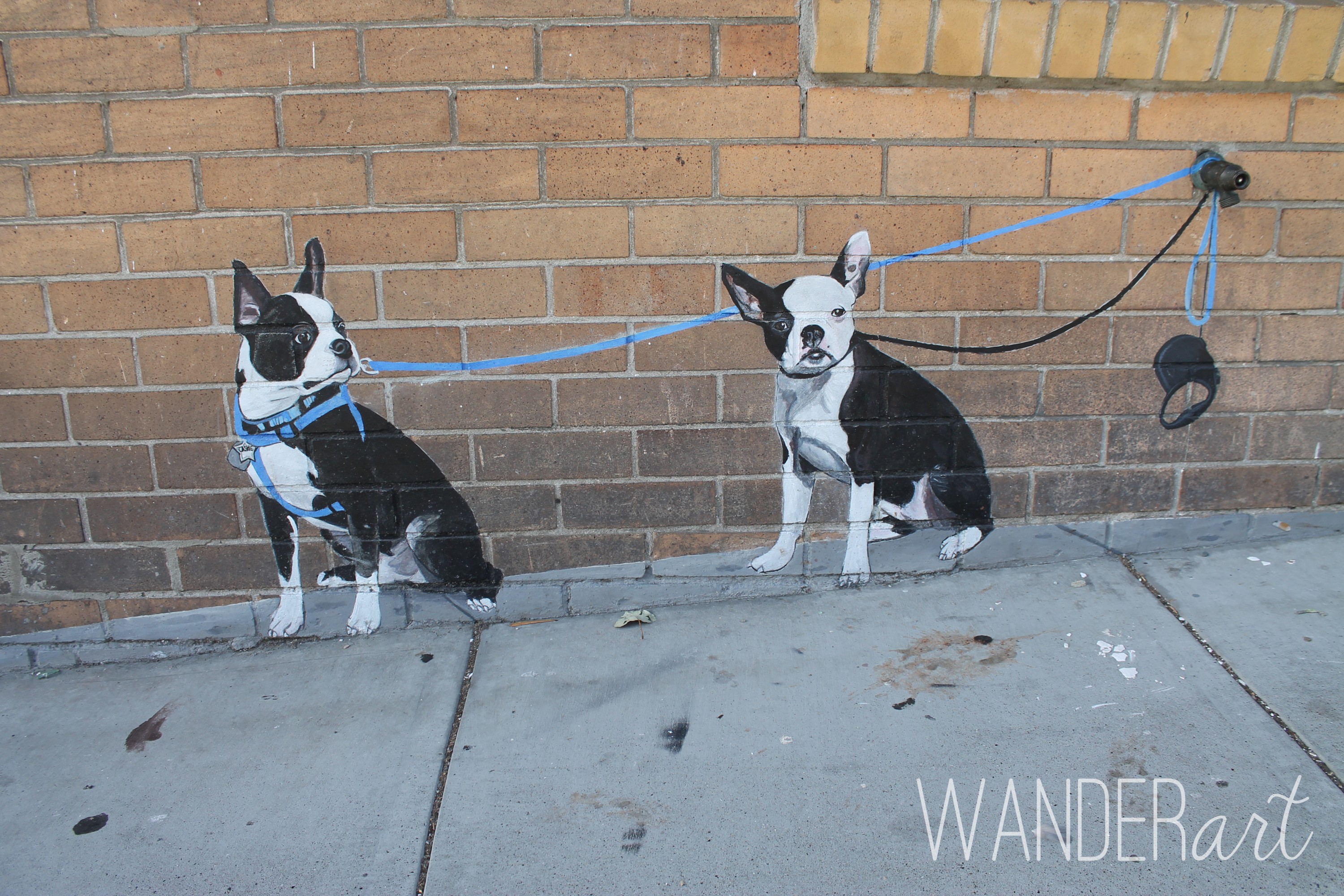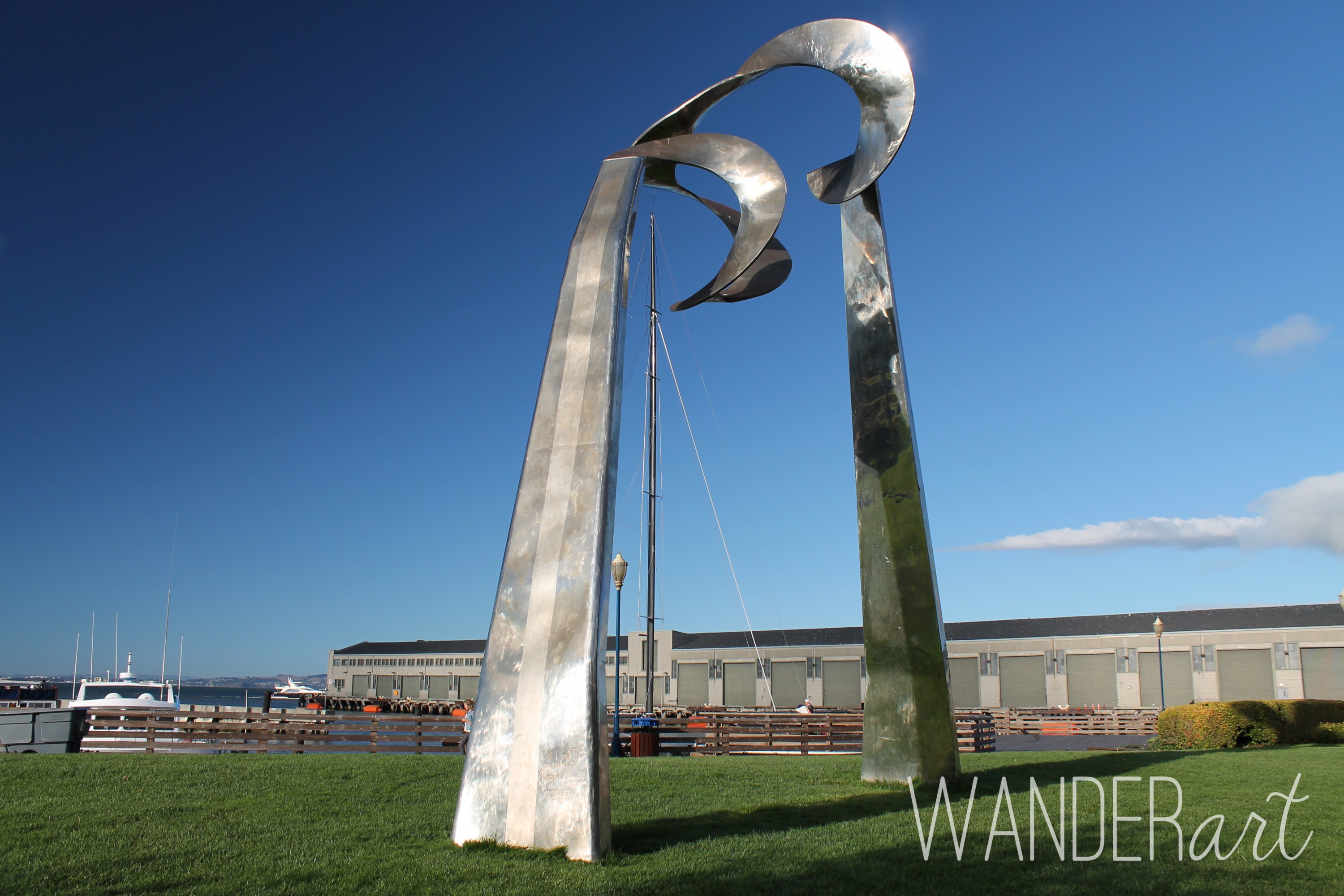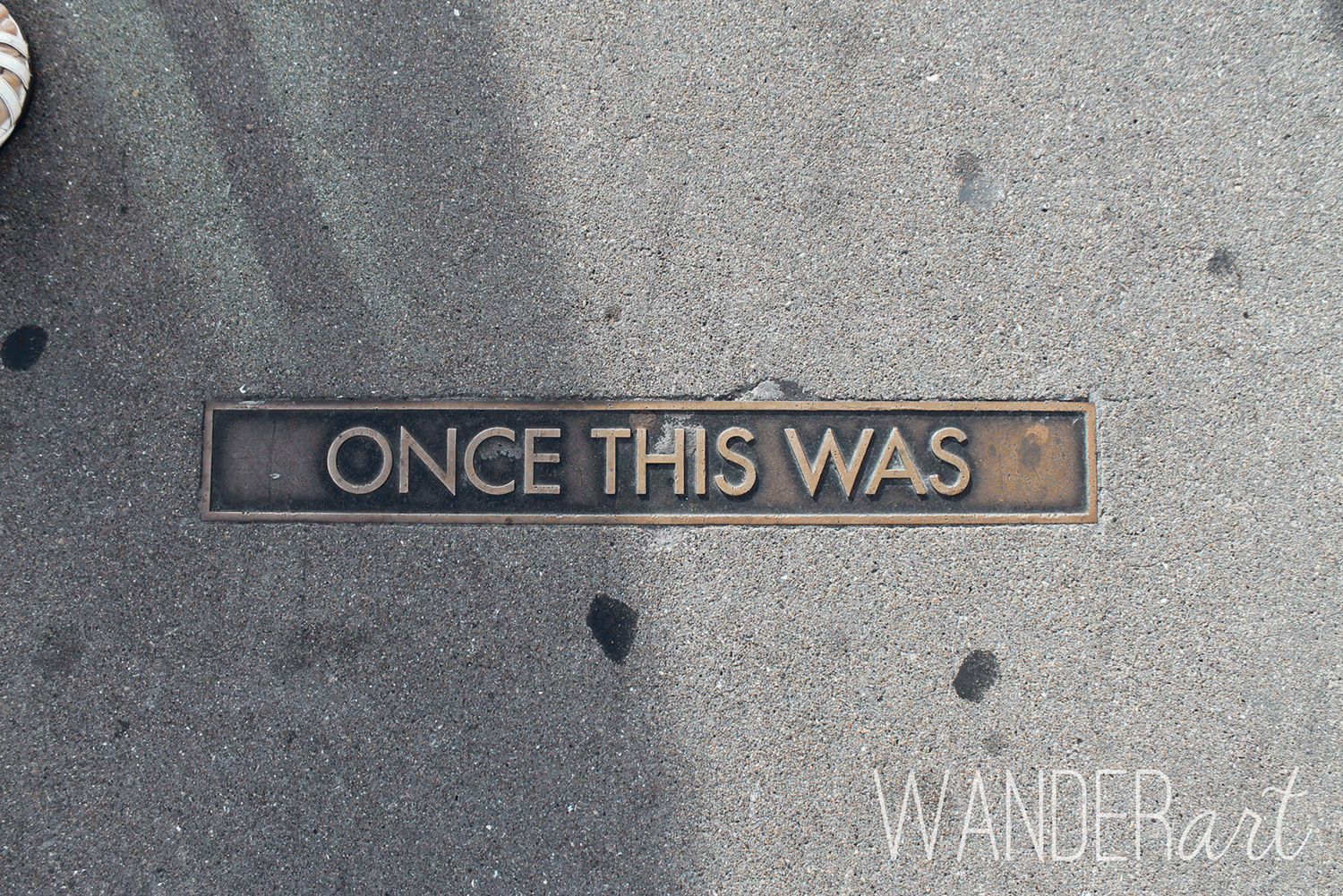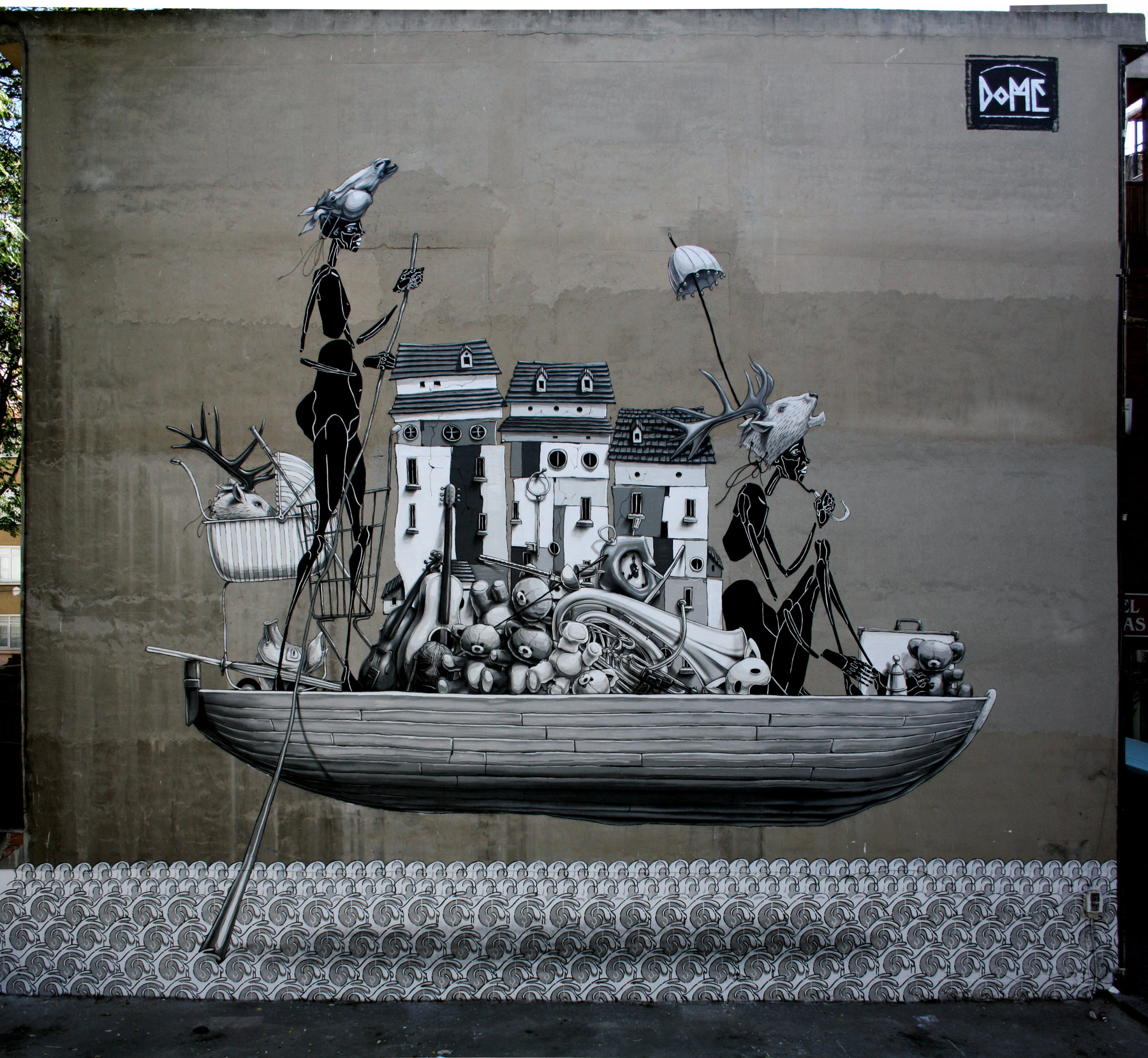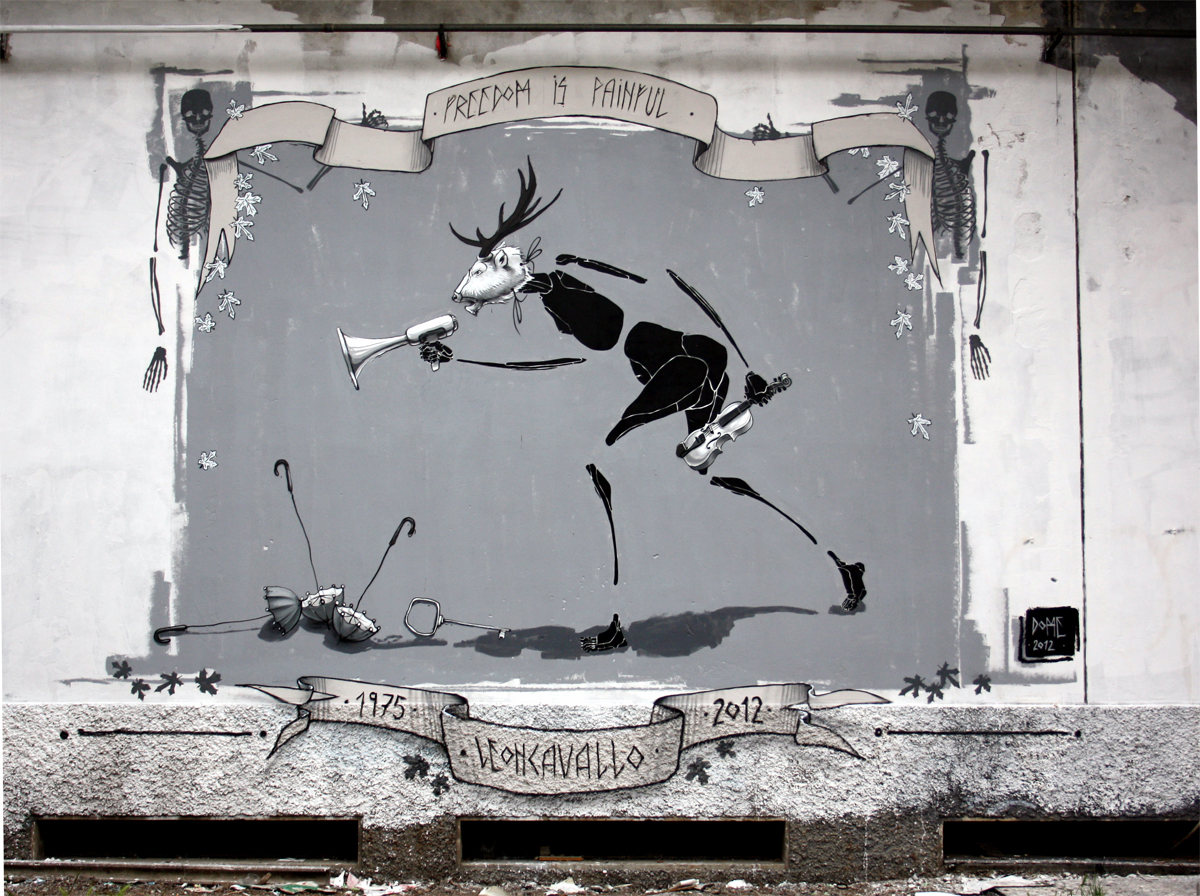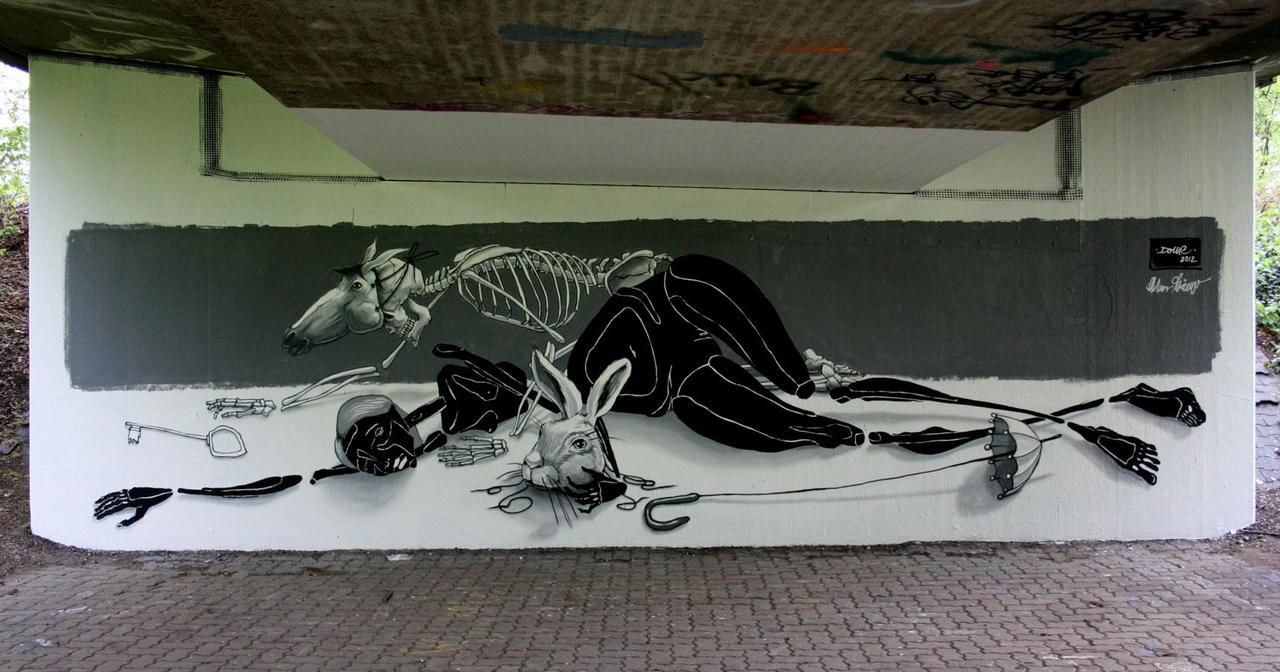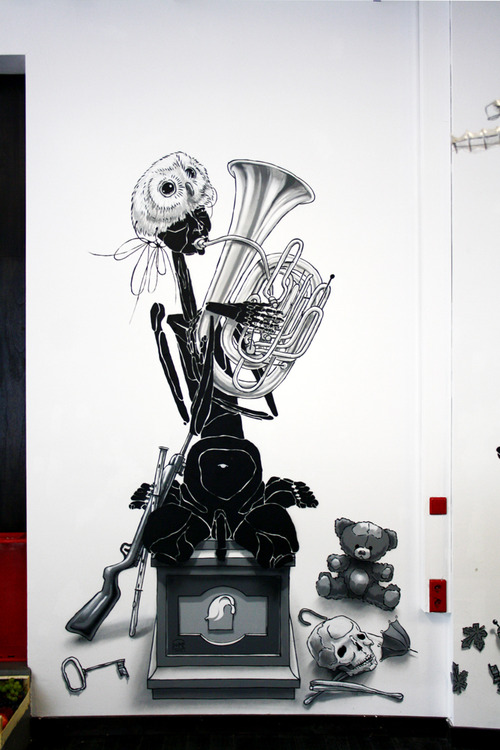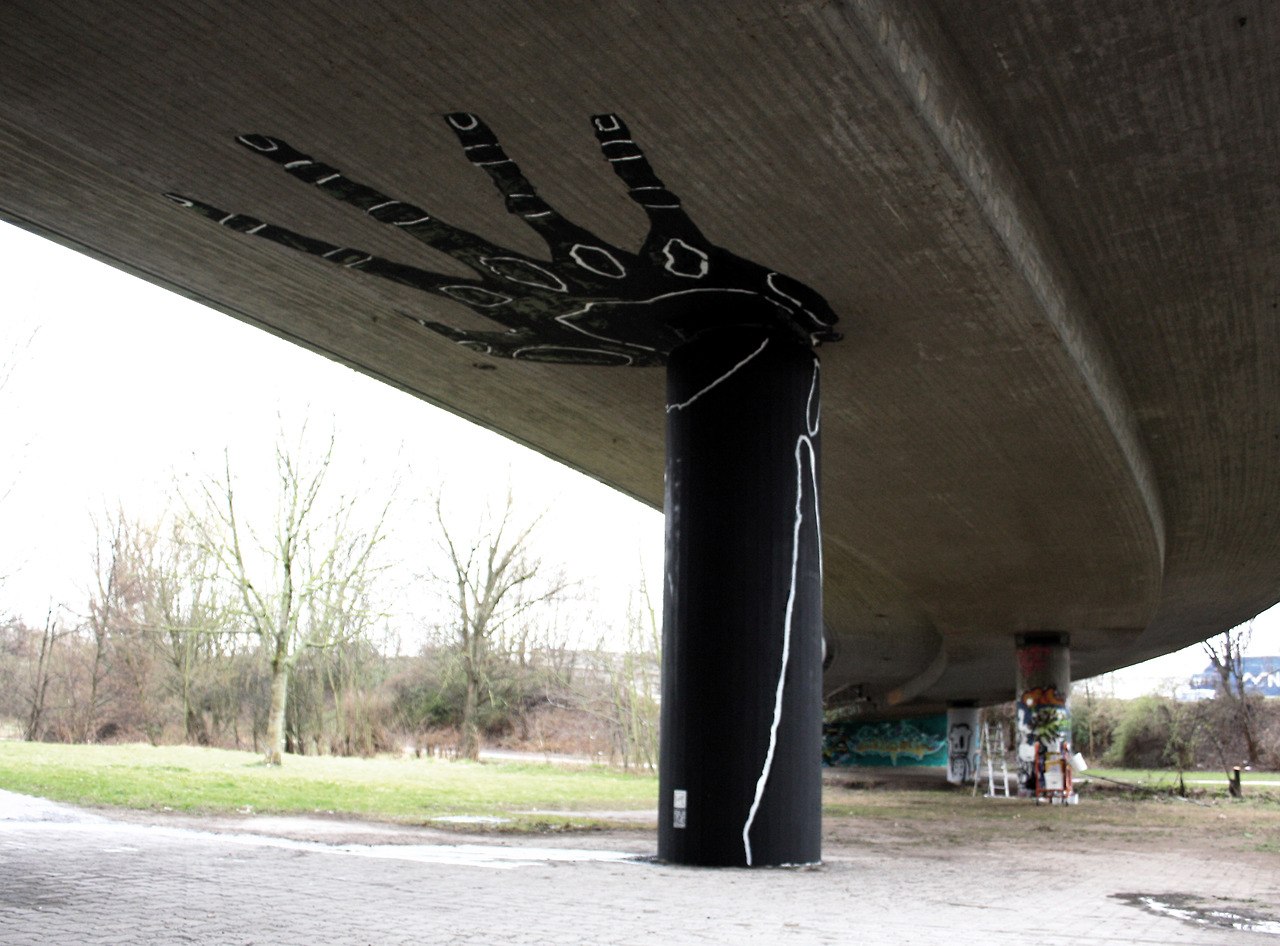Feminist Street Art Sparked by the Egyptian Revolution
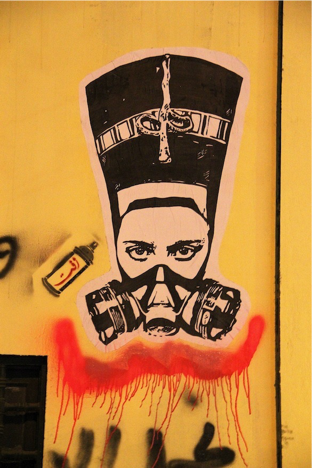
“Nefertiti”
El Zeft
Cairo, 2012
The Arab Spring that shook the Middle East saw two huge waves of protest in Egypt, both with nationalist and feminist undertones. The first in January 2011 overthrew President Hosni Mubarak whose 30-year reign saw a massive oppression of the Egyptian people perpetuated through overwhelming police brutality and corruption of power. The second began in June 2013 and overthrew newly elected President Mohamed Morsi whose rewrite of the Egyptian Constitution granted himself unlimited governmental powers. The Internet’s social tools gave these movements a global audience, and many women were directly involved in the organization and rallying of these revolutions. When the protests themselves transformed into a place of abuse and harassment for women — both by government forces and fellow protestors — outrage sparked a galvanized feminist movement desperate to protect Egyptian women from further harm. This movement was visualized on the streets of Cairo, Alexandria, Mansoura and Suez, where images of powerful women were painted as a feminist voice amongst the revolutionary graffiti that gave the uprisings a uniting cultural vision.
The newfound unification of the Egyptian people against their tyrannical government erupted on January 25, 2011, and was fueled by women as much as men. Young bloggers like Asmaa Mahfouz and Esraa Abdel Fattah rallied all Egyptians to join the protest through flyers, Youtube videos and blog posts. In the days leading up to Mubarak’s resignation, the women protesting in Tahrir Square accounted for 40-50 percent of the activists, when in previous protests they had accounted for 10 percent at most. Following the overthrow of Mubarak, all sense of solidarity between genders, religions and social classes seems to have vanished. In March 2011 a march in honor of International Women’s Day in Tahrir Square ended disastrously. After weeks of protest groups numbering in the hundreds of thousands, only a couple hundred women and a handful of men gathered in support of giving women a voice in the formation of a new Egypt. The protestors were soon surrounded by swarms of men hurling insults and even sexually harassing and groping women. Sami Sade, a journalist for Rose Al Youssef said, “They were shouted at by some men who told them to ‘go back to the kitchen.’” The protesters were chased from the square and those who returned the following day only found more hostility. Amnesty International reported that on March 9, 2011, 18 women were detained and tortured by security forces. All but one were strip searched and forced to undergo “virginity tests.” Several received one-year suspended sentences for charges including disorderly conduct, destroying property, obstructing traffic and possession of weapons.
The abuse of women only continued throughout Egypt’s subsequent protests. On the second anniversary of Egypt’s revolution, 43-year-old freelance journalist Hania Moheeb went to Tahrir Square to join the celebration, but the atmosphere was remarkably different than it had been two years before. “Something was wrong. There were negative vibes in the air,” she told the BBC, “All of a sudden I found myself inside a very, very huge circle of men who were attacking every inch of my body.” Hundreds of men participated in and witnessed Moheeb being stripped, brutally raped and strangled with the scarf around her neck. The attack lasted for more than a half hour, and five of her attackers even followed her into the ambulance where they continued assaulting her. This is only one horrific example of the violence inflicted on Egyptian women by men who face no consequences for their actions — often security and government officers are the ones perpetrating the abuse, whether verbal or physical. Ninety-nine percent of Egyptian women have reported experiencing some form of sexual harassment, and 96.5% reported some form of physical violation. The 10 days of protests that ousted President Mohamed Morsi in June and July 2013 saw 186 reported cases of harassment and abuse. In 2013 Thomson Reuters found Egypt to be the worst country for women outranking Iraq, Saudi Arabia and Syria. The so-called “circle of hell” ambush Moheeb experienced has become so common in Egyptian protest environments that Researcher at Nazra for Feminist Studies, Masa Amir has identified the strategy as a premeditated trap where men comb the crowd looking for women to attack, and as many as three circles of men surround her and prevent her escape. The circle closest to her strips and molests her, the second circle acts as if they are trying to get past the innermost circle to help (but when and if they do only perpetrate more abuse), and the third circle distracts the other people in the square from realizing what’s happening.
More than three such circles surround the woman in Egyptian artist Mira Shihadeh’s mural depicting the trauma suffered by Moheeb in Tahrir Square in 2013. Titled “Circle of Hell,” the painting shows a saddened solitary woman gazing out at the viewer, surrounded by those three circles of attackers on either side, with the crowd of thirsting men appearing to continue endlessly in the background and foreground. Blood pours from the men’s mouths and two knives point toward the woman’s neck. A reminder of a horrific event that’s become commonplace and inconsequential, the mural speaks to Egyptian women as a warning, and Egyptian men as a cautionary tale, or in some cases a mirror. Shihadeh’s work might be syntactically simple and formally caricatured, but its basis in real-life events and the Egyptian flags that fly in the background reveal just how unsuccessful the Egyptian Revolution was for so many of the people who fought for change.
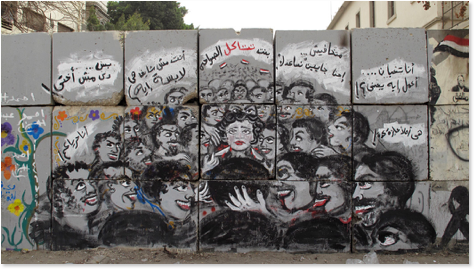
“Circle of Hell”
Mira Shihadeh and El Zeft
Cairo, 2014
Shihadeh has painted other images of women suffering at the hands of men, but her most recognizable piece is a woman fighting back. A woman in heels with her hand on her hip uses a can of spray paint to drown miniaturized figures coming toward her. Shihadeh has painted multiple versions of this image; sometimes the woman is veiled other times her hair flows free, sometimes she’s dressed in red, other times in white, and in still others she’s just a silhouette. But in every iteration the words “no to sexual harassment” are written in Arabic beneath the outpouring of paint from her can.
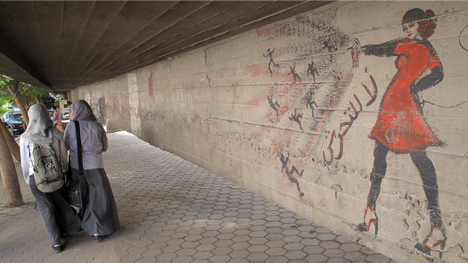
Mira Shihadeh
Cairo, 2013
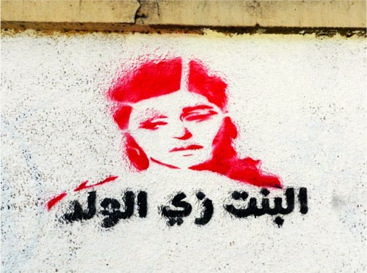
“Girls and Boys are equal”
Nooneswa
Mohamed Mahmoud Street, Cairo, 2011
The incredible increase in violence against Egyptian women since the Revolution has sparked the creation of dozens of murals and stencils painted in public spaces; works intended to humanize women, both by revealing the despair of their helplessness like in “Circle of Hell,” and by showing how powerful women are and have been throughout Egypt’s history. Many of the murals and street artworks created have been supported by newly formed graffiti and street art organizations, determined to foster social change with just paint. Artist and activist Merna Thomas cofounded the community NooNeswa (Noon El Neswa) in 2012 as a way to combat the graffiti that appeared during and after the January 2011 revolution that spoke just to men and were often derogatory towards women. On the one-year anniversary of the “virginity tests” that occurred the day after the failed International Women’s Day march, the group launched their project “Graffiti Harimi,” a graffiti campaign that created stencils of powerful Egyptian women alongside text advocating for women’s equality. One of the most popular stencils depicts iconic Egyptian actress Soad Hosny above the text “A Girl is just like a Boy.” In an interview for the documentary “Shout Art Loud,” Thomas said “Graffiti has this power to insert some images or some messages to people very subliminally or very unconsciously because if you’re passing by an image for a long time, for months, for a year, it starts talking to you, you start having a dialogue with it.” Another of NooNeswa’s stencils shows the outlines of three women’s faces: the first wears a niqab that covers her head and face, the second wears a hijab that covers her hair and the third wears no headscarf at all. Beneath reads the text “Don’t label me,” a powerful message that illustrates the choice of veiling as the personal decision it is, one belonging only to the women who choose to wear it.
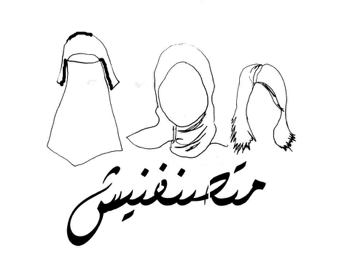
“Don’t label me”
Nooneswa
Stencil design, 2012
Another influential street art group is the organization Women On Walls (WOW) which began in 2013 as women-empowerment graffiti initiative. Its first edition included a collaborative mural covering the inside of a cement garage in Cairo and additional murals in Cairo, Alexandria, Luxor and Mansoura. Prior to painting in Mansoura, the WOW artists engaged the local women in a discussion on the issues that concerned them most so that the walls could be a direct reflection of the community’s needs. While sexual harassment is at the forefront of women’s issues in Cairo, in Mansoura the women said they’re worried about money and the role their appearances play in attaining financial security. In response, artist Ghadir Wagdy painted three successive women’s faces with free flowing hair and their mouths wide open, tongues stuck out in an act of rebellion.
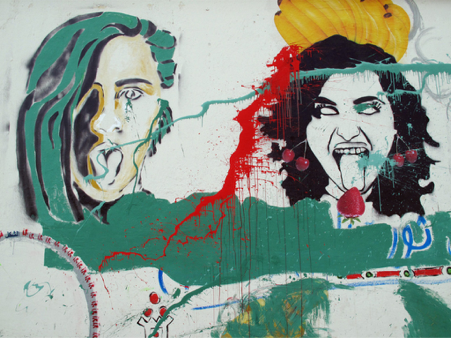
“Exorcism” (detail)
Ghadir Wagdy
Mansoura, 2013
WOW has brought subsequent editions of its campaign to Egypt each year since its launch. In 2014, 20 Egyptian artists collaborated on murals for two additional Cairo walls that focused on the theme ‘Women in the Public Space.’ In 2015 they organized a week-long graffiti celebration called WOW Unchained, which included film screenings and a closing event of music and performances. Twenty artists from all over the Middle East and Sweden gathered to paint together on a wall at Cairo’s technology office park, the GrEEK Campus. The building’s face included an open graffiti wall that invited the public to write and draw messages and images in support of women and women’s rights.
Although most women unsurprisingly feel more comfortable painting in large groups with organizational support, many brave women go out to stencil or paint their work alone. Hend Kheera, a 28-year-old structural engineer and fashion designer first started stenciling during the 2011 uprising. She goes out early in the morning to paint before heading to work, “so no one gives me any trouble,” she told Rolling Stone in a 2012 interview. She’s painted many political works directly antagonizing Egypt’s disappointing series of failed leaders, but syntactically her works resemble NooNeswa’s “Graffiti Harimi” project. She creates portraits of famous Egyptian celebrities above text demanding that women be respected. Generally her work is more controversial, as the text she includes often forcefully demands or threatens men on behalf of women, taking an aggressive and some might even say masculine approach to address abusers and harassers. One of her most well-known works shows the back of a woman’s silhouette; she has one hand on her hip and another on her shoulder in an exaggerated pose, surrounded by the words “Don’t touch or castration awaits you.” “You write on a wall in the street to speak to people,” Kheera said, “[Artists] have a tool not many people have — to express themselves — and maybe they can capture something nobody notices, focus on it and somehow show it in a visually beautiful way.”
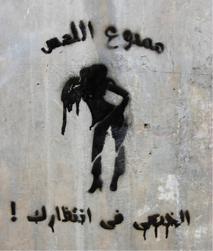
“Don’t Touch”
Hend Kheera
Cairo, 2013
Another woman working to change how women are viewed through street art is Lebanese-Egyptian art historian Bahia Shehab who created the “A Thousand Times No” campaign during the 2011 revolution. “I am a quiet person, I don’t know how to scream,” she told Denmark’s Louisiana Museum of Modern Art in 2014. “My contribution to the revolution was to paint on the walls, was to be an artist.” The title of the series comes from a common Arabic saying that’s meant to confirm and emphasize rejection. She collected a thousand symbols that play on the word “no” in Arabic script and represent facets of oppression in Egypt’s long history. These she transformed into stencils that demand a stop to the tyranny, to the burning of books, to military rule, and to the stripping of women. That last one took the form of a stencil of a blue bra accompanied by the text “No to the stripping of people” — a direct reference to a video that surfaced during the 2011 protests of a woman being beaten by police who stripped her of her clothes and revealed her blue bra. “The blue bra is to remind us of our shame as a nation when we allow a veiled woman to be stripped and beaten on the street,” Shehab explained in a 2012 TED Talk. The blue stencil is often accompanied by a footprint that reads “Long live a peaceful revolution.” “My work is more concerned with memory, because of the intensity and speed of events people tend to forget,” she said.
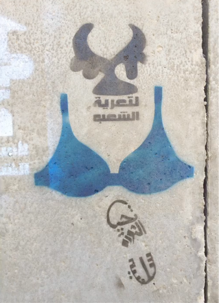
“No to the stripping of people”
Bahia Shehab
Cairo, 2012
Some street artists refer to themselves only by their tag names, so there’s no way of knowing if they’re men or women. One such artist is The Mozza, a street artist working in wheat paste throughout Cairo. The Mozza’s work is exclusively portraits of women, usually done in black-and-white with intricate patterns inscribed within the folds of their clothing and veils. Some of the women are conversing with one another, some are solitary figures, but all of them are faceless — a circle of white devoid of a mouth to speak their minds and eyes to bear witness to what surrounds them. These works simultaneously speak to men and women, confronting men about the way they see women as objects undeserving of what makes someone human. Alternatively, the series allows both men and women to see themselves or their loved ones faces within the figures, in a sense transforming them into representations of the every-woman. Perhaps the most important are images created of women in positions of power. In one piece completed in Cairo, a crowned woman seated in nobility is holding the abstracted framework of a building in her lap. Her air of authority and the fact that she’s not overtly female makes the image more approachable to men, while showing every girl and woman the queen she can be.
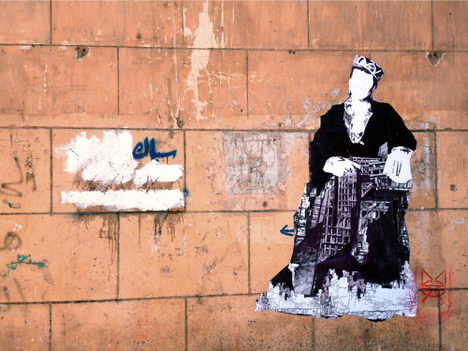
The Mozza
Wheatpaste
Suburb of Cairo, 2014
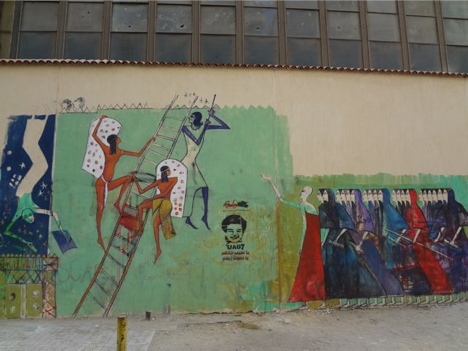
“Marching Women / Women Climbing Ladder”
Alaa Awaad
Cairo, 2012
Male street artists have also played a huge role in creating women-centric works in Egypt. Alaa Awad is an artist and Assistant Lecturer in Fine Art Luxor’s painting department. In 2012 he painted neo-pharaonic scenes of powerful women. “Marching Women/Women Climbing the Ladder” was compositionally based on a carving in the wall of the Ramesseum temple, the mortuary temple of Pharaoh Ramesses II constructed in the 13th century BCE. Awad’s large-scale mural painted in Cairo shows one group of women holding scrolls representative of knowledge walking forcefully in unison towards three women climbing a ladder. In the depiction in the Ramessuem temple the ladder leads to the afterlife where the deceased Pharaoh waits for them, but in Awad’s depiction the ladder leads towards progress, and only women see the necessity of reaching the top.
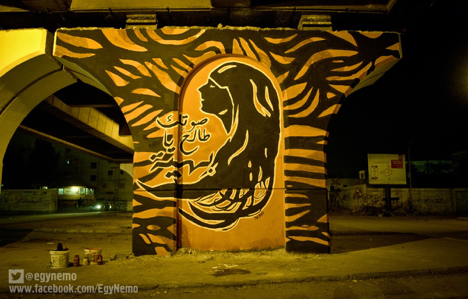
“Baheia, your voice is rising”
NeMo
Mansoura, 2013
This and many of Awad’s other works visually express the importance women have always had in the fostering of Egypt: “We can’t know our future if we forget our past,” he said. Popular Egyptian street artist NeMo has also created works in support of women. A 2013 mural painted under a bridge in Mansoura is titled “Baheia, your voice is rising.” It shows the profiled silhouette of a woman with her head scarf and hair flowing out beneath her, the waves of black echoed in the leaf-like pattern surrounding the portrait. Baheia refers to a common Arabic name for girls that means “beautiful” or “brilliant.” Perhaps the most famous example of feminist street art in Egypt is El Zeft’s 2012 portrayal of 14th century BCE Queen Nefertiti with a gas mask on her face. He shared a photo of the work online with the caption: “A tribute to all women in our beloved Revolution. Without you we wouldn’t have gotten this far. Thank you.” Nefertiti stares straight at the viewer with a look of defiance, protected both against the tear gas unleashed on protestors and against the fumes from her own spray paint cans.

“Nefertiti”
El Zeft
Cairo, 2012
A small victory for this movement was won when sexual harassment was criminalized in June 2014, punishable by up to five years in prison. But unfortunately vaginal penetration is the only form of abuse that can be prosecuted, so women who are molested in other ways still have no protection. The rising violence against women has been combatted with art in numerous ways both indoor and out, but this essay samples the most well-known and widespread examples. The earliest works were direct references to specific traumatic events, like a visual memory bank reminding the Egyptian community that the 2011 uprisings brought suffering along with the success of ousting the Mubarak regime. Nearly all of the street art supporting Egyptian women is figurative, collectively working to visually separate a woman’s body and face as entities distinct from her value as a human being. The inclusion of text takes some of these works a step further, ensuring that the meaning isn’t misinterpreted. Some of the pieces use aesthetics to draw the viewer in to contemplate meaning, but all of them share the common message that women contribute value to society outside the home. “In our case, we are not trying to install beauty. We have not yet reached that level,” Bahia Shehab said, “We communicate ideas of change to society. Because we believe in change and we believe in art as a tool for change. We are still in survival mode.”
Sources
Alaa Awad — the artist —. علاء عوض. “The Missing Murals.” Accessed October 17, 2015. http://alaa- awad.com/the-missing-murals.
Amnesty International. “Egypt: Admission of force ‘virginity tests’ must lead to justice,” May 31, 2011. Accessed October 15, 2015. https://www.amnesty.org/en/latest/news/2011/05/egypt-admission- forced-virginity-tests-must-lead-justice.
Biggs, Cassie. “Women make their power felt in Egypt’s revolution.” The National, February 14, 2011. Accessed October 14, 2015. http://www.thenational.ae/news/world/middle-east/women-make- their-power-felt-in-egypts-revolution.
Coletu, Ebony. “Visualizing Revolution: The Politics of Paint in Tahrir.” Jadaliyya, April 18, 2012. Accessed October 16, 2015. http://www.jadaliyya.com/pages/index/5136/visualizing- revolution_the-politics-of-paint-in-ta.
Downey, Michael. “The Writings on the Wall.” Rolling Stone: June 2012.
El-Rifae, Yasmin. “Egypt’s Sexual Harassment Law: An Insufficient Measure to End Sexual Violence.” Middle East Institute: July 17, 2014. Accessed October 21, 2015. http://www.mei.edu/content/at/ egypts-sexual-harassment-law-insufficient-measure-end-sexual-violence.
Guerin, Orla. “Egypt sex assault victims face long wait for justice.” BBC News: Cairo, October 24, 2013. Accessed October 14, 2015. http://www.bbc.com/news/world-middle-east-24657713.
Kearl, Holly. Stop Global Street Harassment: Growing Activism Around the World. (Santa Barbara: Praeger, 2015), 41-45.
Khamis, Sahar. “The Arab ‘Feminist’ Spring?” Feminist Studies, Vol. 37, No. 3, Feminist Histories and Institutional Practices (Fall 2011), p. 692-95.
Louisiana Channel. “Bahia Shehab: Art as a Tool for Change.” Louisiana Museum of Modern Art: 2014. Accessed October 15, 2015. http://channel.louisiana.dk/video/bahia-shehab-art-tool-change.
NeMo .. Just Street Artist. “صوتك طالع يا بهية Baheia, your voice is rising.” Accessed October 20, 2015. http://egynemo.blogspot.com.eg/2013/10/baheia-your-voice-is-raising.html.
Pangburn, DJ. “Street artist El Zeft pays tribute to Egypt’s female rebels.” death and taxes, September 27, 2012. Accessed October 19, 2015. http://www.deathandtaxesmag.com/189107/street-artist-el- zeft-pays-tribute-to-egypts-female-rebels.
Patry, Melody. Shout Art Loud. Cairo, Egypt: Index on Censorship, 2014. https:// www.indexoncensorship.org/shoutartloud.
Schultz, Colin. “In Egypt, 99 Percent of Women Have Been Sexually Harassed.” Smithsonian Magazine, June 13, 2014. Accessed October 14, 2015. http://www.smithsonianmag.com/smart-news/ egypt-99-women-have-been-sexually-harassed-180951726.
Shehab, Bahia. “A thousand times no.” Filmed June 2012, TED Talk. Accessed October 13, 2005. https:// www.ted.com/talks/bahia_shehab_a_thousand_times_no.
Sholkamy, Hania. “Women Are Also Part of This Revolution.” In Arab Spring in Egypt, edited by Bahgat Korany and Rabab El-Mahdi, 153-174, American University in Cairo Press, 2012.
The Mozza. “in the daytime….” Accessed October 20, 2015. http://themozza.tumblr.com.
Thomson Reuters Foundation. Annual Report: Inform. Connect. Empower. London: 2013. Accessed October 15, 2015. http://www.trust.org/documents/annual-report-2013.pdf.
United Press International (UPI). Activists: Rapists use ‘circle of hell.’ Cairo: February 21, 2013. Accessed October 14, 2015. http://www.upi.com/Top_News/World-News/2013/02/21/Activists- Rapists-use-circle-of-hell/UPI-61851361480254/#ixzz2LvSOXlfp.
Women On Walls. “About WOW 2013.” Accessed October 12, 2015. http://womenonwalls.org/in- mansoura-join-us-or-if-you-cant-follow-our-daily-journal-and-flickr.
Women On Walls. “Site 1: Boursa Cafe’ Area.” Accessed October 12, 2015. http://womenonwalls.org/ site-1-boursa-cafe-area.
Women On Walls. “WOW UNCHAINED.” Accessed October 12, 2015. http://womenonwalls.org/wow- unchained.

